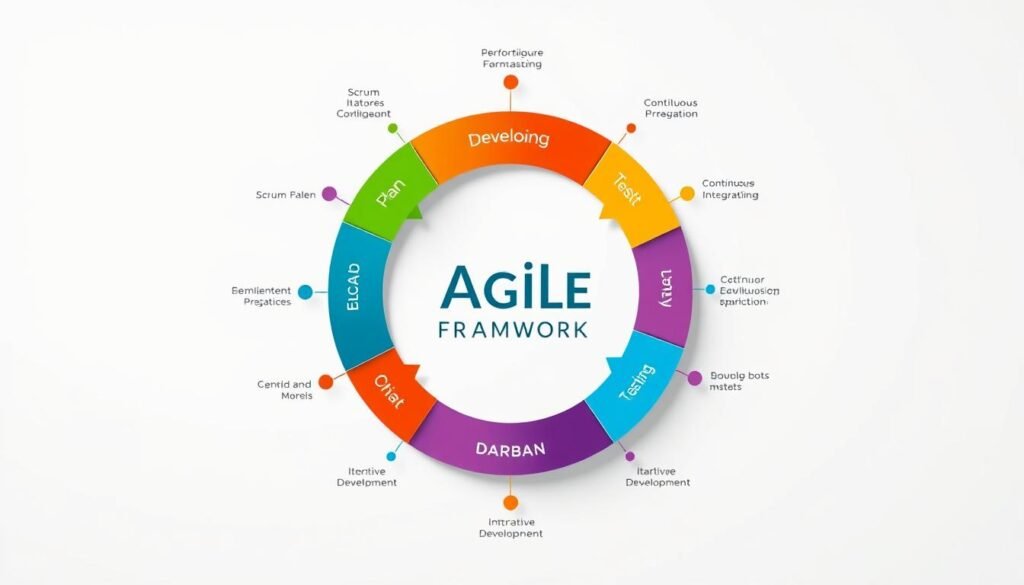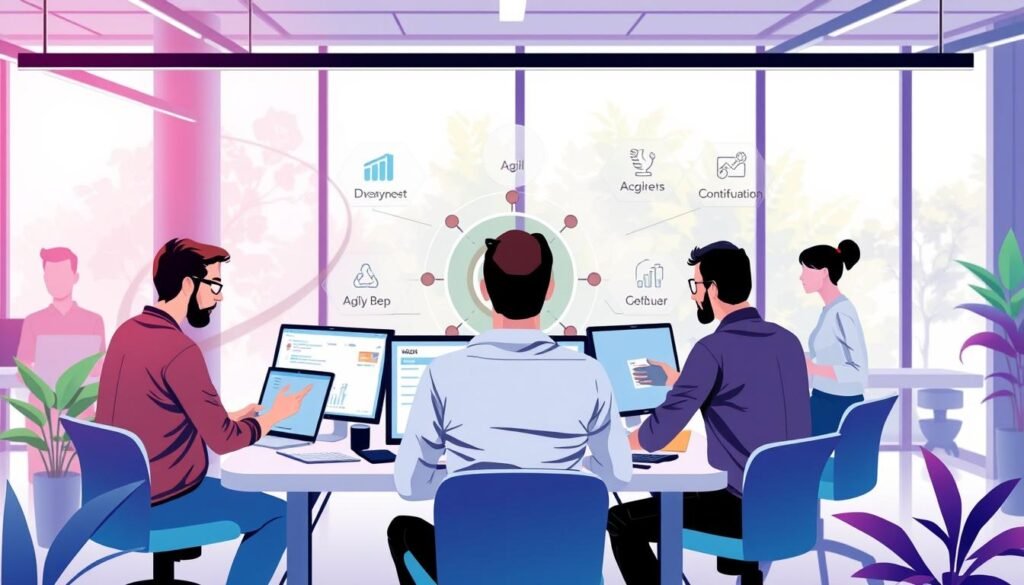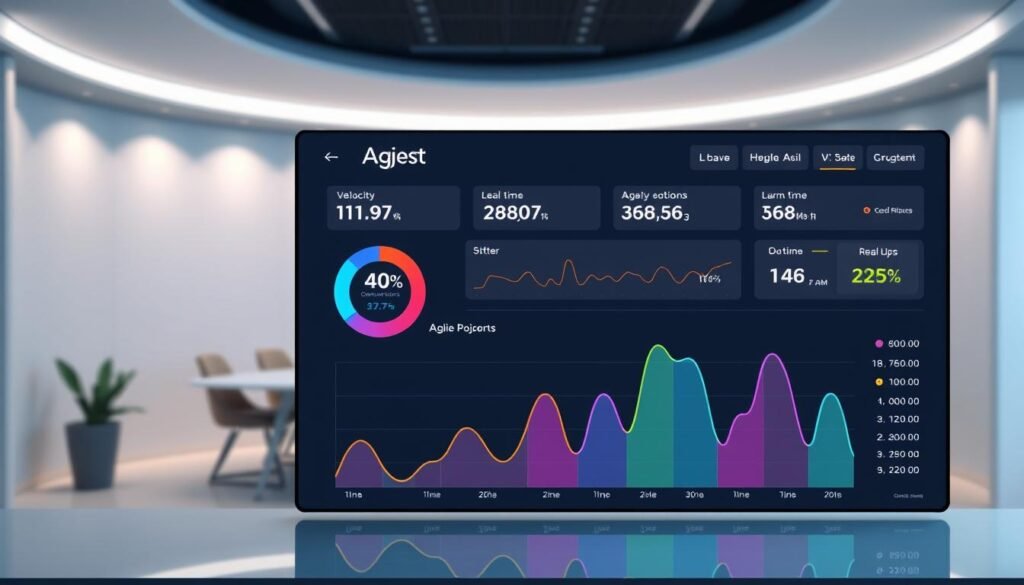In today’s fast-paced IT landscape, being agile is essential for project success. We know how vital it is to adapt quickly and stay ahead.
Our Agile methodologies let clients quickly adjust to changing needs. This ensures faster delivery and better outcomes. By using Agile development, we help companies reach their goals more effectively.
For more information or inquiries about our IT agile services, please contact us at info@consac.dev.
Understanding Agile Development

The Agile methodology has changed IT development services. It focuses on being flexible and working together. Knowing its core principles and history is key.
What is Agile Development?
Agile development is a way to manage projects that changes and adapts. It brings small, steady improvements through teamwork. This method works well when things often change.
At its heart, Agile is about embracing change and meeting customer needs. Teams work together, share knowledge, and make decisions together. This way, Agile ensures products are of high quality and meet customer expectations.
History of Agile Methodologies
The Agile methodology started with the Agile Manifesto in 2001. A group of software developers created it. The manifesto has four core values:
- Individuals and interactions over processes and tools
- Working software over detailed documentation
- Customer collaboration over contract talks
- Adapting to change over sticking to a plan
These values have shaped Agile frameworks and practices over time. Agile has grown, adding Scrum and Kanban, each with its own practices and principles.
Key Principles of Agile Development
Agile development follows key principles for efficient value delivery. Important principles include:
| Principle | Description |
|---|---|
| Iterative Development | Breaking work into small parts and delivering them in steps. |
| Continuous Improvement | Always looking to improve processes and practices. |
| Flexibility | Being open to change and adjusting plans as needed. |
| Collaboration | Encouraging teamwork and active participation from all. |
By following these principles, teams can fully benefit from Agile. For more info or to start using Agile, contact us at info@consac.dev.
Benefits of IT Agile Services

Agile IT services bring many benefits. They improve teamwork, flexibility, and how fast you can get to market. By using Agile, companies can make their development work better.
Enhanced Collaboration and Communication
Agile services help teams work better together. They make sure everyone is talking and working towards the same goals.
Teams meet often and share feedback. This keeps everyone on the same page and up to date on the project.
Increased Flexibility and Adaptability
Agile is all about being flexible. Teams can adjust to new needs quickly. This makes sure the final product is what the client wants.
This flexibility is key in today’s fast world. Needs can change fast, and Agile helps teams keep up.
Faster Time-to-Market
Agile lets businesses get their products out faster. This gives them an edge over the competition.
By focusing on small, working pieces of software, teams can quickly meet market demands and customer feedback.
| Benefits | Description | Impact |
|---|---|---|
| Enhanced Collaboration | Fosters open communication and teamwork | More effective project execution |
| Increased Flexibility | Adapts to changing requirements | Meets evolving client needs |
| Faster Time-to-Market | Releases products and features sooner | Gains competitive edge |
Want to know more about Agile IT services for your business? Or interested in our services? Contact us at info@consac.dev.
The Agile Software Development Lifecycle

Using the Agile framework means being flexible and adaptable in software development. It’s all about working in cycles, making changes fast, and delivering quality software quickly.
Phases of Agile Development
The Agile process has key phases: planning, development, testing, and deployment. Each step is important for project success. In planning, teams set goals and outline the work.
Development and testing happen in cycles, with feedback loops to ensure quality. This ensures the software meets standards.
Jeff Sutherland, co-creator of Scrum, said, “The Scrum framework is designed to bring out the best in teams, to create an environment where people can work together effectively, and to produce high-quality products.” This shows Agile’s focus on teamwork and improvement.
Continuous Integration and Delivery
Continuous integration and delivery are key in the Agile framework. Integrating code often helps find and fix problems early. This reduces risks. Continuous delivery keeps software ready for release, allowing teams to quickly meet changing needs.
- Frequent code integration
- Automated testing and validation
- Continuous delivery to production
Importance of Feedback Loops
Feedback loops are essential in Agile. They help teams get insights and make adjustments. This cycle ensures the product is high-quality and meets user needs.
By using feedback, teams can improve their work, adapt to changes, and deliver valuable software.
“The most painful thing is losing your idea, losing your vision, because someone else has a different vision.” –
For more on how Agile services can help your business, or to learn about our development methods, contact us at info@consac.dev. We’re excited to work with you and help achieve success.
Popular Agile Frameworks
The Agile methodology has many frameworks, each with its own strengths. These frameworks help teams use Agile practices well. We’ll look at Scrum, Kanban, and Lean Software Development, three popular ones.
Scrum
Scrum is a top Agile framework known for its structured way and clear roles. It values teamwork, accountability, and moving forward in steps. Scrum uses sprints, daily stand-ups, and retrospectives for constant betterment.
Key components of Scrum include:
- Product Owner: Defines and prioritizes the product backlog.
- Scrum Master: Helps the Scrum process and clears obstacles.
- Development Team: A team that works on the product backlog items.
Kanban
Kanban is a well-liked Agile framework that focuses on seeing the work flow and controlling it. It aims for continuous delivery and betterment, without Scrum’s strict rules. Kanban boards help teams see their work and find where things slow down.
The main principles of Kanban include:
- Visualize the workflow.
- Limit work in progress (WIP).
- Focus on flow and lead time.
Lean Software Development
Lean Software Development is an Agile framework that aims to cut waste and increase value. It uses lean manufacturing ideas for software development. Lean is about delivering value fast and efficiently, cutting waste and improving processes.
Core principles of Lean include:
- Eliminate waste.
- Amplify learning.
- Decide as late as possible.
- Deliver as fast as possible.
For more on using these Agile frameworks in your projects, or to learn about our Agile services, contact us at info@consac.dev.
Agile vs. Traditional Development Approaches

Understanding the differences between Agile and traditional methods is key for success in software development. The choice between these approaches can greatly affect a project’s outcome.
Key Differences Explained
Agile focuses on flexibility, iterative development, and continuous delivery. It lets teams quickly adapt to changes and deliver software in short cycles.
Traditional methods, on the other hand, are more linear and predictable. They rely on a detailed plan and sequential steps. This makes it hard to change the project once it starts.
Pros and Cons of Each Approach
Agile has its advantages and disadvantages. It boosts collaboration, faster delivery, and quick adaptation. But, it can lead to scope creep if not managed well.
Traditional methods offer a clear structure and predictable results. They’re good for projects with set requirements and timelines. But, their rigidity can be a problem in fast-changing environments.
For more info or to learn how Agile can help your project, contact us at info@consac.dev. We’re here to help you succeed in software development.
How Agile Services Drive Innovation

The Agile transformation journey is more than adopting new methods. It’s about creating a culture of innovation. By using Agile practices, organizations can open up new ways for creativity and growth.
Encouraging Creativity in Teams
Agile services create a team environment where everyone can experiment and innovate. This method boosts problem-solving skills and leads to innovative solutions. It empowers teams to own their projects, unlocking the collective creativity of its members.
Agile’s continuous feedback and integration make innovation ongoing, not just a single event. This way, teams can keep improving their ideas and adapting to new needs. This ensures the final product meets the changing user demands.
Leveraging User Feedback for Improvements
User feedback is key in Agile development. By actively using and applying user feedback, organizations can make sure their products are focused on users. This boosts customer happiness and drives business success.
We think using user feedback is vital for innovation. For more on how Agile services can help your business, or to ask questions, contact us at info@consac.dev.
Choosing the Right Agile Software Solutions

There are many Agile software solutions out there. Teams must pick the best one for their needs.
The right Agile software tools are key to project success. We must think about several important factors to choose the best solutions.
Factors to Consider
When picking Agile software, consider these key factors:
- Team Size and Structure: The software should fit your team’s size and structure.
- Project Complexity: Think about your project’s complexity and if the software can handle it.
- Desired Features: Know the features your team needs, like project management or version control.
Agile experts say, “The right tool can greatly improve development, but it’s important to choose based on your needs.”
“Agile is not just a methodology, it’s a mindset that requires the right tools to be effective.”
Evaluating Tool Options
It’s important to compare different tools when choosing Agile software. Here’s a look at some popular ones:
| Tool | Key Features | Scalability |
|---|---|---|
| Jira | Project management, issue tracking | High |
| GitLab | Version control, continuous integration | High |
| Trello | Kanban boards, project management | Medium |
For more information or inquiries about Agile software solutions, please contact us at info@consac.dev.
Implementing Agile Practices in Your Organization

Agile implementation is a complex process that needs careful planning and execution. As organizations try to adopt Agile, they must consider several key factors. This ensures successful integration.
Steps for Successful Adoption
To adopt Agile practices well, start by training your teams on Agile principles and methodologies. This foundational step is key. It ensures all team members understand the Agile framework and their roles.
- Set clear goals and objectives that match Agile principles.
- Start with small pilot projects to introduce Agile methodologies.
- Encourage a culture of continuous improvement and feedback.
By following these steps, organizations can lay a solid foundation for Agile adoption. It’s also vital to continuously monitor progress and adjust as needed.
Common Challenges and Solutions
Despite Agile’s benefits, organizations often face challenges during implementation. Common issues include resistance to change, lack of understanding, and inadequate support from leadership.
- Resistance to Change: Overcome this by providing thorough training and involving team members in the Agile adoption process.
- Lack of Understanding: Reduce this by setting up clear communication channels and providing ongoing support.
- Inadequate Support: Make sure leadership is committed to Agile adoption and provides the necessary resources.
For more information on implementing Agile practices or to inquire about our IT agile services, please contact us at info@consac.dev. We can guide you through Agile adoption complexities and ensure a smooth transition.
Measuring Success in Agile Projects

The success of an Agile project is shown by its value to users and its ability to change with new needs. Teams must pick the right metrics and make sure their work meets user needs.
Tracking key performance indicators (KPIs) is key to knowing how well a team is doing. These metrics give insights that help teams improve their work.
Key Performance Indicators (KPIs)
KPIs like velocity, lead time, and defect density are important for checking Agile project success. Velocity shows how much work a team does in a sprint, helping predict future work. Lead time shows how long it takes to deliver a feature, showing how efficient the team is. Defect density is about the number of defects in relation to the project size, showing the product’s quality.
| KPI | Description | Benefit |
|---|---|---|
| Velocity | Measures work completed during a sprint | Predicts future team performance |
| Lead Time | Time taken for a feature to be delivered | Highlights development efficiency |
| Defect Density | Number of defects relative to project size | Indicates product quality |
Importance of User Satisfaction
While KPIs give numbers, user satisfaction is just as important. It shows if the product meets user needs and expectations. We make sure user feedback shapes our development to improve.
By looking at both KPIs and user satisfaction, teams can measure success in a complete way. For more on Agile practices or to learn about our services, reach out at info@consac.dev.
Future Trends in Agile Development Practices
Agile development is changing fast, thanks to new trends. Now, teams are working together from different places. This is made easier by Agile software that helps everyone stay connected.
Remote Teams and AI Integration
More teams are working remotely, and AI is helping them work better. AI and automation make the development process smoother. This means teams can do more in less time.
For companies to keep up with software development, they need to adapt. Using Agile methods and the right tools can help. This way, businesses can grow, work better together, and achieve more. To learn more about these changes and how to adapt, contact us at info@consac.dev.

